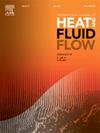鱼尾涡发生器和三角涡发生器在热交换器中增强热电性能的实验与数值研究
IF 2.6
3区 工程技术
Q2 ENGINEERING, MECHANICAL
International Journal of Heat and Fluid Flow
Pub Date : 2025-05-03
DOI:10.1016/j.ijheatfluidflow.2025.109869
引用次数: 0
摘要
本文研究了鱼尾涡发生器和三角涡发生器对热电发电机(TEG)换热器性能的影响。系统分析了涡发生器构型的高差比(D/H)和倾角(θ)对温度分布、压降、传热系数(HTC)、努塞尔数、摩擦系数和热增强系数(TEF)等关键热工参数的影响,以及它们对功率输出和转换效率等性能指标的影响。采用一维稳态传热方法对换热器和热电发生器系统进行建模,假设热风不可压缩流具有恒定的热物理性质。当倾角为60°时D/H值为2、3和4时,鱼尾型和三角型VGs在D/H = 2时的出口控制体积内HTC增幅最大,分别为535.7%和333.0%,D/H = 3时分别为448.6%和293.6%,D/H = 4时分别为359.6%和289.9%。当D/H比为2、3和4时,压降最大值(D90)与最小值(F30)的差值分别为97.2%、96.0%和86.13%。当D/H = 2, θ = 60°时,鱼尾涡组构型的热增强系数(TEF)最高,为4.97。对应的,当D/H值为2、3、4时,该配置的输出功率分别记录为1.62 W、1.60 W、1.54 W。而当D/H = 4, θ = 60°时,TEG转换效率达到3.29%的峰值。本研究结果强调了涡发生器在提高余热回收潜力方面的有效性。本文章由计算机程序翻译,如有差异,请以英文原文为准。
Thermoelectric performance enhancement by employing fishtail and delta-shaped vortex generators in a heat exchanger: An experimental and numerical study
The present study investigates the influence of fishtail and delta-shaped vortex generators on the performance of a heat exchanger integrated with a thermoelectric generator (TEG). The effects of the distance-to-height ratio (D/H) and the inclination angle (θ) of the vortex generator configurations on key thermohydraulic parameters—temperature distribution, pressure drop, heat transfer coefficient (HTC), Nusselt number, friction factor, and thermal enhancement factor (TEF)—along with their impact on TEG performance metrics, namely power output and conversion efficiency, are systematically analyzed. The heat exchanger and thermoelectric generator system is modeled using a one-dimensional steady-state heat transfer approach, assuming incompressible hot air flow with constant thermophysical properties. For D/H values of 2, 3, and 4 at an inclination angle of 60°, the maximum percentage increase in HTC within the exit control volume is observed as 535.7 % and 333.0 % for fishtail and delta-shaped VGs at D/H = 2, followed by 448.6 % and 293.6 % at D/H = 3, and 359.6 % and 289.9 % at D/H = 4, respectively. The pressure drop exhibits a significant variation, with the disparity between the highest (D90) and lowest (F30) values recorded as 97.2 %, 96.0 %, and 86.13 % for D/H ratios of 2, 3, and 4, respectively. The highest thermal enhancement factor (TEF) is attained for the fishtail VG configuration at D/H = 2 and θ = 60°, with a value of 4.97. Correspondingly, the power output for this configuration is recorded as 1.62 W, 1.60 W, and 1.54 W for D/H values of 2, 3, and 4, respectively. However, the peak TEG conversion efficiency of 3.29 % is achieved at D/H = 4 and θ = 60°. This study’s findings underscore vortex generators’ efficacy in augmenting waste heat recovery potential.
求助全文
通过发布文献求助,成功后即可免费获取论文全文。
去求助
来源期刊

International Journal of Heat and Fluid Flow
工程技术-工程:机械
CiteScore
5.00
自引率
7.70%
发文量
131
审稿时长
33 days
期刊介绍:
The International Journal of Heat and Fluid Flow welcomes high-quality original contributions on experimental, computational, and physical aspects of convective heat transfer and fluid dynamics relevant to engineering or the environment, including multiphase and microscale flows.
Papers reporting the application of these disciplines to design and development, with emphasis on new technological fields, are also welcomed. Some of these new fields include microscale electronic and mechanical systems; medical and biological systems; and thermal and flow control in both the internal and external environment.
 求助内容:
求助内容: 应助结果提醒方式:
应助结果提醒方式:


